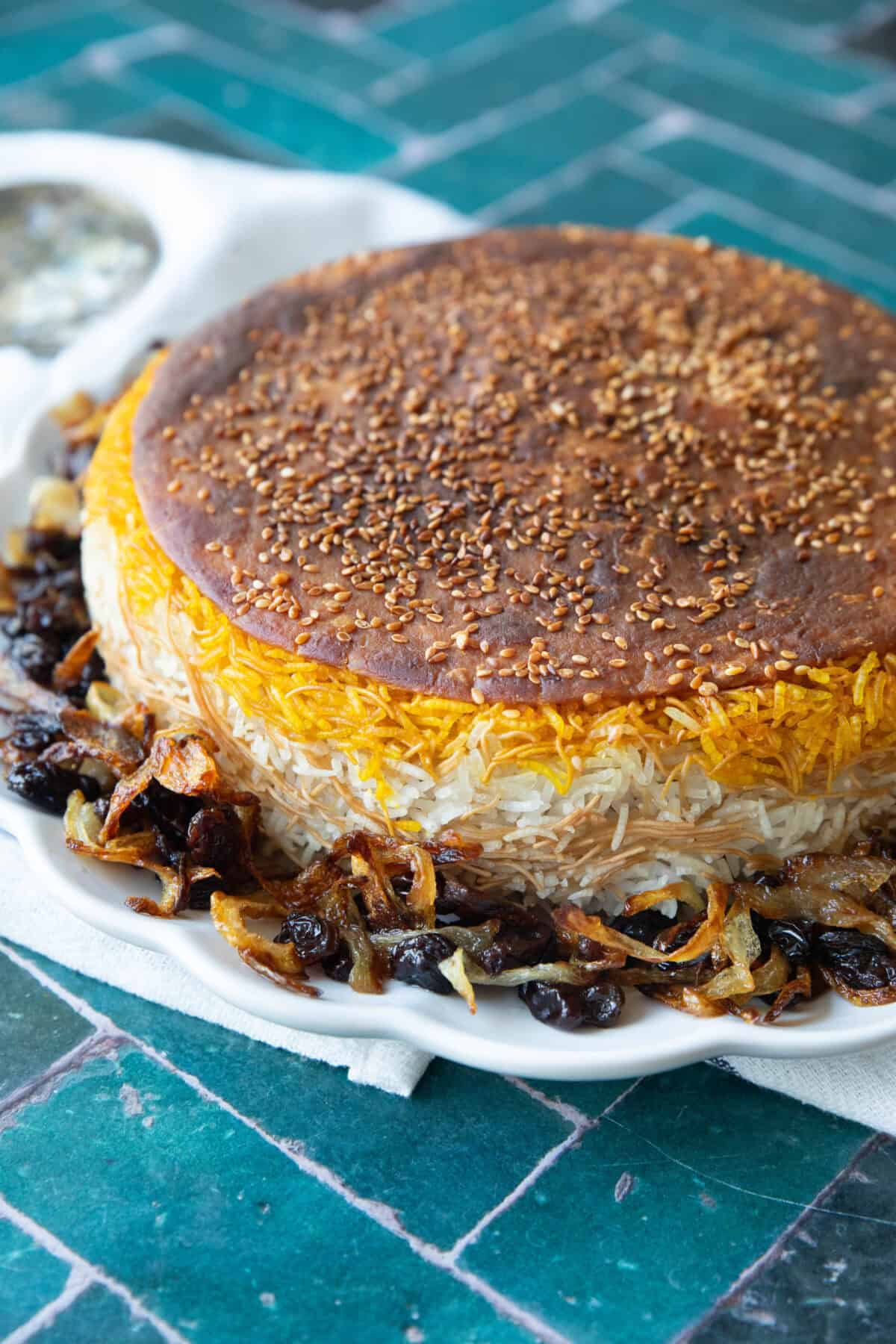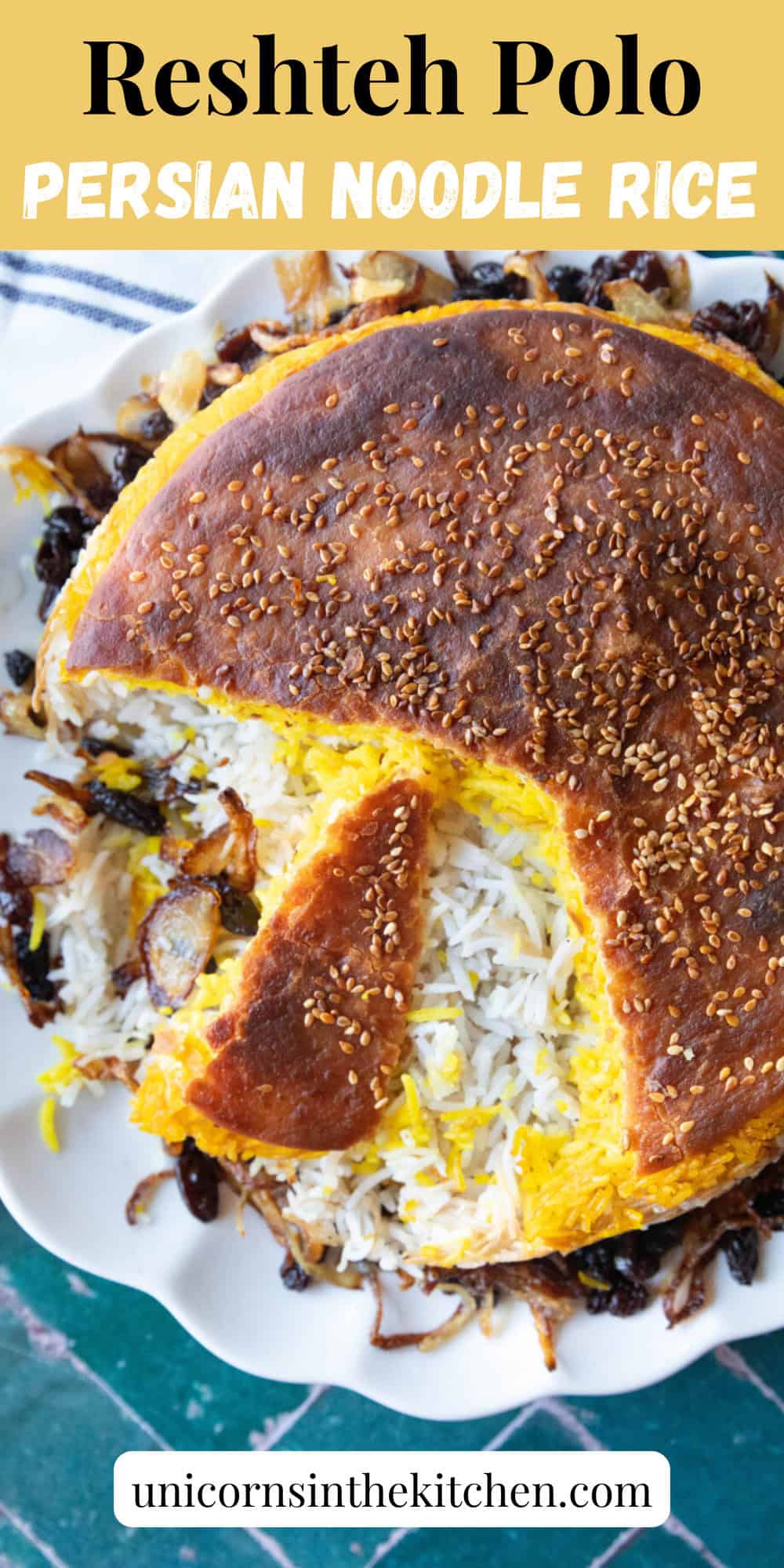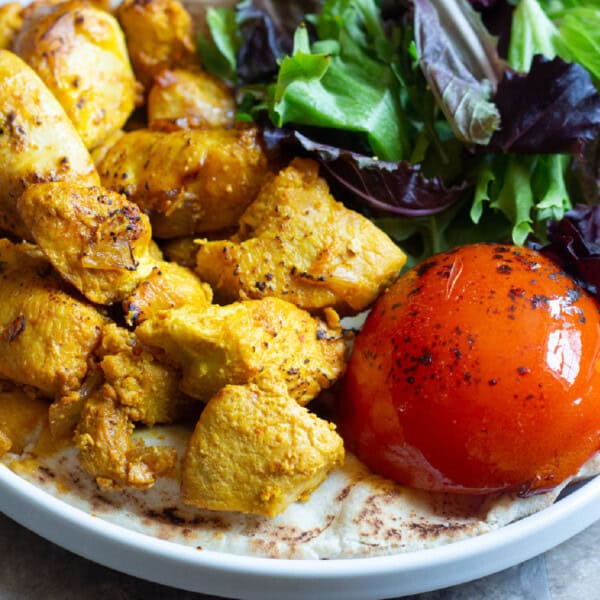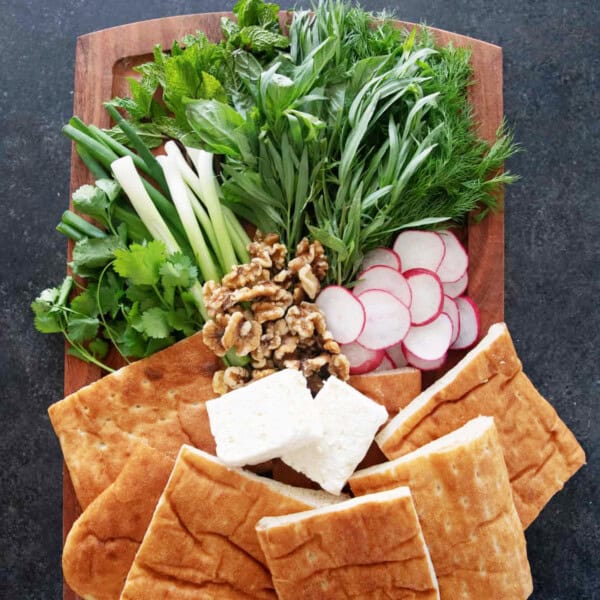This post may contain affiliate links.
Reshteh Polo, or Persian Noodle Rice, is a cherished dish in Iranian cuisine, often prepared for Nowruz (Persian New Year) and other festive occasions. This flavorful dish combines fragrant basmati rice with toasted Persian noodles, creating a unique balance of tender and crispy textures.

Whether served alongside saffron chicken or enjoyed with meatballs, this Persian noodle rice dish embodies the warmth and traditions of Persian culinary heritage. Also, fish tahdig, pan seared cod with saffron cream sauce, kuku sabzi and sabzi polo are recipes served during Nowruz and have deep roots in the Iranian heritage. For dessert, Persian rice cookies are a beloved sweet treat that perfectly complements the festive meal.
What is Reshteh Polo?

Reshteh polo (rice with noodles) is a fragrant and symbolic Persian dish made with basmati rice and reshteh, a type of Persian noodle.
This rice dish is particularly popular during Nowruz, as noodles in Persian culture represent the path of life, making this meal a traditional way to welcome new beginnings.
The rice is cooked with broken noodles, which give it a slightly nutty flavor and a unique texture. It’s often layered with bloomed saffron, topped with crispy tahdig (a golden, crunchy layer at the bottom of the pot), and garnished with caramelized onions and raisins for a balance of savory and sweet.
Usually, Iranians serve Persian noodle rice with saffron chicken, making it a festive and flavorful meal that holds deep cultural significance.
Ingredients

Saffron: Blooming saffron in ice instead of boiling water allows it to release its rich golden color and floral aroma without bitterness. Read more about blooming saffron and how to use it.
Basmati Rice: Rinsing and soaking the rice removes excess starch, ensuring a light, fluffy texture.
Reshteh Polo Noodles: These Persian noodles are slightly toasted and have a nutty flavor. You can find them in Persian stores or buy them online. You can use Middle Eastern vermicelli noodles instead.
Tortilla: I use tortilla for tahdig. It forms a crispy, golden base for the rice. However, you can use potatoes, any other kind of flatbread, or just a layer of rice.
Butter: Adds richness to the rice. Use ghee for a deeper taste or olive oil for a lighter alternative.
Onions: I usually caramelize them for garnish.
Raisins: These add a touch of sweetness that contrasts beautifully with the saffron and savory elements. If you don’t like raisins, simply leave them out.
How to Make Reshteh Polo
Step 1: Bloom the Saffron
Grind saffron strands using a mortar and pestle. Sprinkle them over ice cubes in a small bowl and let them melt. This will be your bloomed saffron.
Step 2: Prepare the Rice and Noodles
Rinse the basmati rice several times until the water runs clear to remove excess starch.
Place the rice in a pot and add water to cover by 1 1/2 inch. Add in salt and olive oil. Bring to a boil until slightly tender but not fully cooked.


Break the reshteh polo (Persian noodles) into pieces, add them to the pot with the rice, and cook until the water has almost evaporated.
Drain in a colander and rinse the rice and noodles quickly with cold water to stop the cooking process.



Step 3: Layer the Tahdig and Rice
Mix ⅓ of the noodles and rice with the bloomed saffron.


In the same pot, heat oil and sprinkle sesame seeds. Then, place a piece of tortilla at the bottom of the pot. This forms the crispy tahdig (crispy bottom layer).


Layer the saffron-infused rice over the tortilla into the pot first, and pack it tight.
Add the remaining rice and reshteh on top and pack it down slightly.


Poke 5 holes into the rice with the handle of a spoon to help steam circulate and dot the surface with 2 tablespoons of butter.


Step 4: Steam the Rice
Cover the lid with a clean kitchen towel and cook over medium heat for 45 minutes until the rice is fluffy and aromatic and the tahdig is golden crisp.
Step 5: Prepare the Garnish
While the rice is steaming, fry the thinly sliced onions in oil until golden brown. In a separate pan, lightly fry the raisins for a minute until plump.
Step 6: Serve
Once cooked, turn the heat off and let the rice sit for 10 minutes. Then place a plate over the pot and carefully flip the rice to reveal the crispy tahdig.
Finally, arrange the caramelized onions and raisins and serve warm.


Serving Suggestions
Reshteh polo is often enjoyed during Nowruz, as it symbolizes the path and transitions of life. However, its comforting and aromatic nature makes it a delightful dish to savor any time of the year.
One of the best pairings for reshteh polo is saffron chicken. It’s a classic Persian dish with saffron-infused chicken, perfectly complementing this flavorful rice. You can pair it with braised lamb and layer them into the rice when serving.
For a refreshing contrast, serve reshteh polo with mast-o-khiar, torshi or shirazi salad.

Recipe Tips
Prevent Sticky Noodles: To avoid mushy reshteh, don’t overcook them in water. They will continue cooking in the steaming process. A quick boil until just softened is enough.
Master the Tahdig: Press the rice down gently and cook it over medium-low heat to achieve the perfect tahdig without burning.
Get Crispy Tahdig: Use medium heat to allow the crust to form slowly. Placing a clean kitchen towel under the lid absorbs excess moisture and helps with crispiness.

Storing the Leftovers
Refrigeration: Store any leftover reshteh polo in an airtight container in the fridge for 3–4 days. Ensure it has cooled completely before storing it to prevent condensation and sogginess.
Reheating: For the best texture, reheat in a non-stick pan over low heat, covered, to help restore the crispy tahdig. Alternatively, sprinkle a little water over the rice and warm it in the microwave in 30-second intervals.
Freezing: While it’s best enjoyed the day you make it, you can freeze reshte polo without the tahdig for up to 1 month. Store it in a freezer-safe container and thaw it in the fridge overnight before reheating.
Tahdig Tip: If you have leftover tahdig, store it separately in an airtight container in the fridge for up to 3 days. Reheat in a dry pan for a few minutes to restore crunchiness.

Frequently Asked Questions
Reshteh Polo has a rich, nutty, and slightly smoky flavor from the toasted noodles combined with the aromatic saffron-infused rice and the sweetness of caramelized onions and raisins. The crispy tahdig adds a delightful crunch to each bite.
For the crispiest tahdig, make sure to heat the oil properly before layering the rice, pack the rice tightly, and cook over medium-low heat with a towel-wrapped lid to trap steam.
While Reshteh Polo is a traditional Persian New Year dish, it’s also enjoyed throughout the year for special occasions, family gatherings, and cozy dinners.

More Recipes for Nowruz
Persian Recipes
Persian Style Branzino Recipe
Persian Recipes
Joojeh Kabab (Persian Saffron Chicken Kebab)
Persian Recipes
Sabzi Khordan (Persian Herb Platter)
All Recipes
Our Best Fried Fish Recipe
Did you make this recipe? I’d love to hear about it! Please comment and leave a 5-star🌟 rating below. You can also follow us on Instagram, Facebook, Pinterest or subscribe to our newsletter to get a free e-Cookbook!

Reshteh Polo (Persian Noodle Rice)
Ingredients
Bloomed Saffron
- ¼ teaspoon saffron strands
- 2 cubes ice
Rice
- 2 cups basmati rice
- 4 ounces reshteh polo (Persian noodles for rice), broken into pieces
- 1 teaspoon salt
- 4 tablespoons neutral flavor oil
- 1 tablespoon sesame seeds
- 1 piece tortilla
- 2 tablespoons butter
Garnish
- 4 tablespoons oil
- 1 onion, thinly sliced
- ½ cup raisins
Instructions
- Grind saffron strands using a mortar and pestle. Sprinkle them over ice cubes in a small bowl and let them melt.
- Rinse the basmati rice several times until the water runs clear to remove excess starch.
- Place the rice in a pot and add water to cover by 1 1/2 inch. Add in the salt and 1 tablespoon of oil and bring to a boil. Cook for 5 minutes until the rice is slightly tender but not fully cooked.
- Break the reshteh polo (Persian noodles) into pieces, add them to the pot with the rice, and cook until the water has almost evaporated.
- Drain them in a colander and rinse them quickly with cold water to stop the cooking process.
- Mix ⅓ of the reshteh noodles and rice with the bloomed saffron.
- In the same pot, add the rest of the oil and sprinkle sesame seeds. Then, place a piece of tortilla at the bottom of the pot for tahdig.
- Layer the saffron-infused rice over the tortilla into the pot first, and pack it tight.
- Add the remaining rice and reshteh on top and pack it down slightly.
- Poke 5 holes into the rice with the handle of a spoon to help steam circulate and dot the surface with 2 tablespoons butter.
- Cover the lid with a clean kitchen towel and cook over medium heat for 45 minutes until the rice is fluffy and aromatic and the tahdig is golden crisp.
- To make the garnish, heat the oil in a pan over medium heat and cook the onions until golden. Add in the raisins and cook for a couple more minutes.
- Once the rice is cooked, turn the heat off and let it sit for 10 minutes. Invert a plate on the pot and carefully flip the rice to reveal the tahdig.
- Arrange the caramelized onions and raisins and serve warm.
Video
Notes
- Prevent Sticky Noodles: To avoid mushy reshteh, don’t overcook them in water. They will continue cooking in the steaming process. A quick boil until just softened is enough.
- Master the Tahdig: Press the rice down gently and cook it over medium-low heat to achieve the perfect tahdig without burning.
- Get Crispy Tahdig: Use medium heat at first, then lower it to allow the crust to form slowly. Placing a clean kitchen towel under the lid absorbs excess moisture and helps with crispiness.
- Make-Ahead Option: You can parboil the rice and reshteh a few hours in advance. Just store them separately, then assemble and steam when ready to serve. However, tahdig is best made fresh for the perfect crunch.
Nutrition
Nutrition information is automatically calculated, so should only be used as an approximation.













